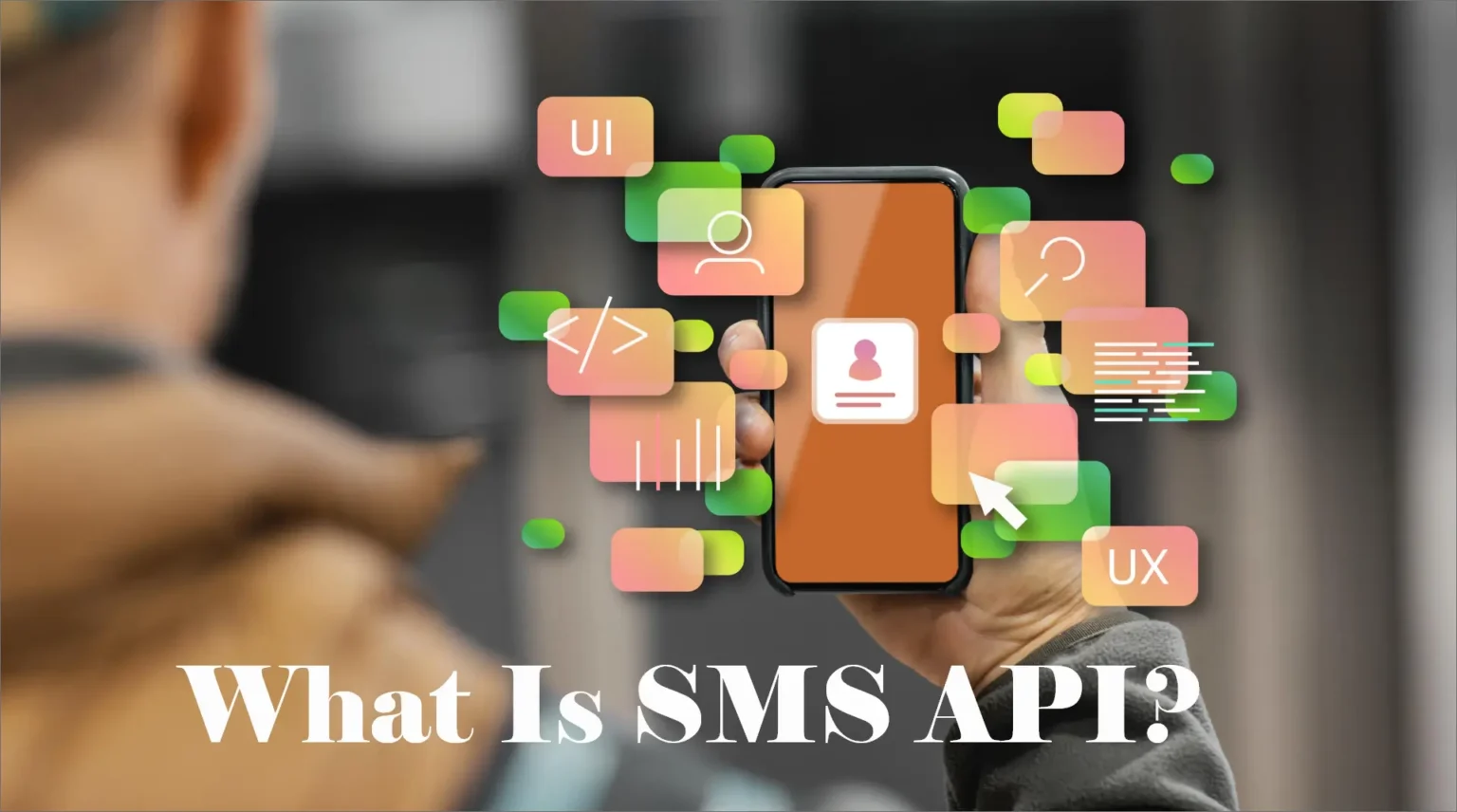In this fastly evolving digital world, communication is the cornerstone of personal and business interactions. Short Message Service (SMS) has remained a popular communication channel for its simplicity, reliability, and near-universal accessibility.
However, as businesses and developers seek to integrate SMS into their applications and services, they often turn to SMS APIs (Application Programming Interfaces) to streamline the process. This comprehensive guide will delve into the world of SMS APIs, exploring what they are, how they work, and their various applications.
First, it is essential to understand API, so let’s start without further ado.
What Is An API?
An Application Programming Interface (API) is a structured framework of rules and protocols facilitating seamless communication between diverse software applications.
APIs enable developers to access specific functions or data from one software component to another, making integrating and extending different systems’ functionality easier.
APIs serve as intermediaries, enabling seamless interactions between software applications.
What Is An SMS API?
An SMS API is a specialized form of API designed to seamlessly integrate SMS (Short Message Service) messaging into your current software systems and applications. With an SMS API, your business can send and receive SMS messages directly through your website or app.
The beauty of an SMS API lies in its ability to ensure your business remains operational around the clock, ensuring prompt customer notifications and information dissemination, even beyond regular business hours.
In contrast to manual systems, such as email, which often demand hands-on involvement, an SMS API streamlines your operations, making your communication with customers more efficient and up-to-date. By eliminating the need for human intervention in routine transactions, you reduce the chances of unnecessary errors and free up valuable resources that can be better allocated elsewhere in your organization.
How Does An SMS API Work?
To understand how an SMS API works, let’s break down the process:
1. Integration
A developer integrates the SMS API into their application by following the API provider’s documentation and guidelines. It typically involves obtaining API credentials (such as API keys) and configuring the API with the necessary settings.
2. Request
When the application needs to send an SMS message, it makes an API request to the SMS service provider via the SMS API. This request includes essential information, such as the recipient’s phone number, message content, and additional parameters.
3. Processing
The SMS API processes the request, validates the provided information, and formats the message for delivery. It also handles tasks like message queuing and scheduling for later delivery if necessary.
4. Delivery
Once the message is processed, the SMS API forwards it to the SMS gateway, responsible for delivering it to the recipient’s mobile device. The gateway communicates with the recipient’s mobile carrier to ensure successful delivery.
5. Response
After the message is delivered or attempted, the SMS API responds to the application, indicating whether the message was sent successfully, failed, or encountered any issues. This response allows the application to handle errors or take appropriate action.
What Are The Applications Of An SMS API?
SMS APIs offer a wide range of applications across various industries and use cases:
i. Business Communication
Many businesses use SMS APIs to send customers and clients transactional messages, appointment reminders, and notifications.
ii. Marketing and Promotions
SMS APIs are famous for sending marketing campaigns, promotions, and special offers to a targeted audience.
iii. Authentication and Verification
SMS APIs are crucial in two-factor authentication (2FA) and account verification processes, enhancing security.
IV. Customer Support
SMS APIs enable businesses to provide customer support and receive inquiries or feedback via text.
V. Alerts and Notifications
Organizations use SMS APIs for sending critical alerts, emergency notifications, and updates to employees or subscribers.
Vi. Appointment Reminders
Healthcare providers and service-based businesses utilize SMS APIs to send appointment reminders, reducing no-show rates.
Vii. OTP (One-Time Password)
SMS APIs are integral for generating and sending OTPs required for user login or transaction verification.
Which Organizations Use SMS API?
A wide array of organizations spanning diverse sectors, can reap substantial benefits by adopting an SMS API for their communication needs. It includes webshops, brick-and-mortar stores, financial institutions, dining establishments, nightlife venues, insurance firms, transportation companies, logistics providers, humanitarian organizations, healthcare entities, IT platforms, and public institutions.
How Much Does It Cost To Use An SMS API?
The cost of using an SMS API can vary significantly depending on several factors, including the SMS service provider, the volume of messages you send, the destination countries, and the specific features or services you require.
Here are some key factors to consider when determining the cost of using an SMS API:
- Message volume
- Destination
- Message type
- Features
- Monthly fees
- Virtual Numbers
- Data and media
It is advisable to contact SMS service providers directly and inquire about their pricing structure to get an accurate cost estimate for using an SMS API. Providers often have pricing calculators or detailed pricing information on their websites to help you estimate your expenses based on your specific needs and usage patterns.
Keep in mind that prices may also change over time, so you need to stay updated on the pricing policies of your chosen SMS API provider.
How To Choose An SMS API Provider?
When selecting an SMS API provider, consider the following factors:
- Reliability: Ensure the provider has a robust infrastructure with high message delivery rates and minimal downtime.
- Pricing: Understand the pricing model, including message rates, volume discounts, and additional fees.
- Scalability: Choose an API that can scale with your application’s growth and increasing SMS volumes.
- Documentation and Support: Look for comprehensive documentation, developer resources, and responsive customer support.
- Compliance: Ensure the provider complies with data protection regulations, such as GDPR, and offers secure transmission of sensitive data.
Why Do Businesses Use SMS APIs?
SMS APIs empower you to effortlessly dispatch thousands of text messages within seconds, all in an automated fashion. This streamlined approach enhances efficiency and fosters a professional and secure omnichannel communication environment, ultimately elevating the customer experience and bolstering support.
Consider the following versatile applications of an SMS API for your business:
- Engage in meaningful, two-way interactions with your customers through SMS, allowing for seamless communication and quick issue resolution.
- Craft personalized bulk SMS messages to resonate with your audience, fostering a more personalized and engaging connection.
- Implement secure one-time passwords for enhanced account security and verification, instilling trust in your user base.
- Keep customers informed about the status of their shipments through SMS, ensuring transparency and peace of mind.
- Promote sales, discounts, and special offers via SMS, directly reaching your target audience and driving sales.
- Enhance flexibility by segmenting campaigns and tailoring messages to specific customer groups for maximum impact.
- Automate routine tasks to free up staff resources for more strategic and value-added activities.
- Schedule time-sensitive messages at predefined intervals, ensuring timely communication with your audience.
Incorporating an SMS API into your business strategy empowers you to optimize communication, boost customer engagement, and streamline operations across various essential functions.
What Is The Role Of SMS API In VoIP Phone System?
Unified Communication
Enhanced Messaging Capabilities
Automated Notifications
Two-Way Communication
Business Process Integration
Customer Engagement
Emergency Notifications
Conclusion - SMS API
In conclusion, an SMS API is a powerful tool that facilitates seamless integration of SMS messaging into various applications and systems. It streamlines communication, enhances customer engagement, and offers various versatile applications across different industries. Whether you’re a business looking to improve customer support, run targeted marketing campaigns, or enhance security through two-factor authentication, an SMS API can be valuable. While the cost of using an SMS API varies,
It is a cost-effective way to leverage the speed, reliability, and universality of SMS in the fast-paced digital world. Embracing SMS APIs empowers businesses to communicate efficiently and effectively in the ever-evolving digital communication landscape. Moreover, integrating an SMS API into a VoIP phone system extends its capabilities beyond voice communication, providing users with additional messaging features.
FAQs
The cost of using an SMS API varies depending on the service provider, message volume, destination countries, and required features. Providers typically offer pay-as-you-go pricing, and the cost per message can range from a few cents to a fraction of a cent.
Some popular SMS API providers include Twilio, Nexmo, Plivo, GatewayAPI, and MessageBird. The choice of provider depends on your specific requirements and location.
While some technical knowledge benefits integration, many SMS API providers offer comprehensive documentation and support to help developers get started. You don’t necessarily need to be an expert to use an SMS API effectively.
Yes, most SMS APIs support international messaging. However, the cost and delivery times may vary depending on the destination country and the SMS service provider’s coverage.
Many SMS APIs can receive SMS messages, allowing your application to process incoming messages and respond accordingly.
SMS messages typically support only plain text. If you need to send multimedia content, you might consider using other messaging services like MMS (Multimedia Messaging Service) or rich communication services (RCS), different from SMS.
Features of SMS APIs typically include:
- Message Sending
- Message Receiving
- Two-Way Communication
- Message Personalization
- Message Scheduling
- Delivery Reports
- Bulk Messaging
- Security:
- Short Codes
- Multi-Language Support
- Integration
- Callback/Webhooks
An SMS API is essential because it enables seamless integration of SMS messaging into applications, enhancing communication, automation, and engagement for businesses and organizations. It allows for efficient customer interaction, secure authentication, and versatile messaging, making it a valuable tool in modern digital communication strategies.
Read More: How To Find Owner Of VoIP Number?
Read More: Are VoIP Phone Systems Reliable?




